|
Location:
Stanton Drew Village, Avon. (ST 600 633). |
Grid Reference: 51� 22.1' N, 2� 34.4' W. |

 Stanton Drew:
(Stone Circle, Henges, Avenues).
Stanton Drew:
(Stone Circle, Henges, Avenues).
This
huge megalithic complex consists of three stone circles, two stone avenues,
a cove of stones and an outlier. The Great Circle is
the second largest English stone ring after the outer circle at
Avebury,
is 112m (368ft) in diameter
and is composed of 27 stones.
Beside it lies the North-East Ring.
It is 29.6m (97ft) across and its eight massive boulders, four of which
still standing, are the biggest of the entire complex. The South-West
Ring, badly ruined and on private land, is not open to the public.
(More
about Triple-circles)
From the two visible circles there are
two avenues running
eastward towards the river Chew. The avenue starting from the North-East
Ring, composed of seven surviving stones, and the wrecked one extending
from the Great Circle, if continued, would have merged into one. The Cove, in a straight line with the centres of the two accessible stone
circles, consists of two huge upright stones with a recumbent slab lying
between them. They are blocks of dolomitic breccia, while the circles'
stones are of pustular breccia and oolitic limestone. The Outlier,
also known as Hautville's Quoit, lies half a kilometer (1850ft)
north-east of the circles, on a high ridge. It is a sandstone boulder, now
recumbent, and it is in a straight line with the centres of the Great
Circle and the South-West Ring.
Burl recognises the presence of four henges at Stanton Drew.
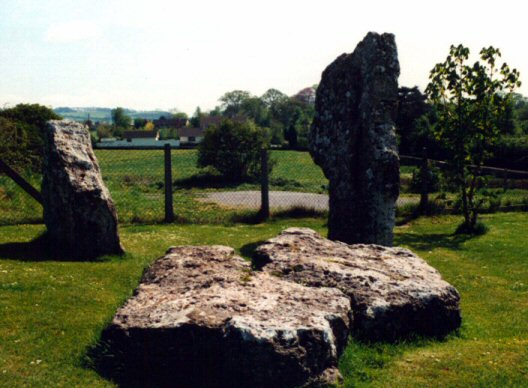
The Nearby Cove in the garden of
the 'Druid's Arms'
Results of Recent Surveys at
Stanton Drew:
English Heritage's Ancient Monuments Laboratory scientists, in recent
geophysical research of the site (with a portable
magnetometer), have discovered that within the
Great Circle are the remains of a highly elaborate pattern of buried pits
that once held massive posts. They are arranged in nine rings concentric
with the stone circle, at the centre of which are further pits. The rings
vary in diameter from 23m to 95m (75.5ft to 311.7ft). The magnetometer
survey also revealed that the Great Circle is itself contained within a
very large ditch 135m (443ft) in diameter. Twice as large as
Stonehenge,
this prehistoric ceremonial site has been described as the biggest in
Britain.
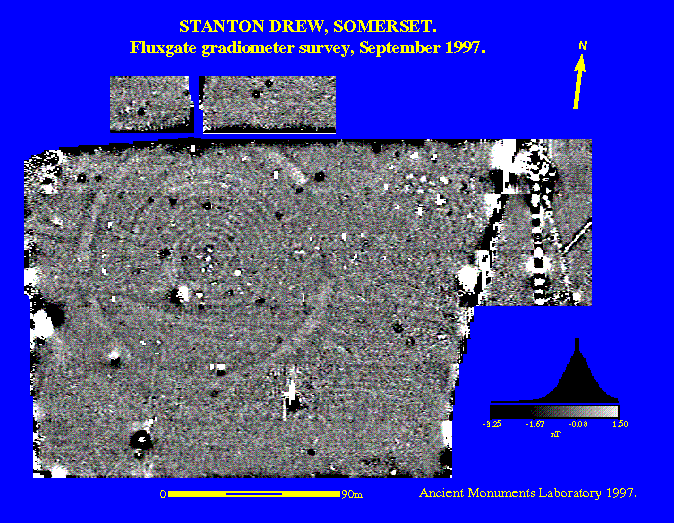
Nine
concentric circles revealed at Stanton Drew.

Schematic of
Stanton Henge with opening to the North-East.
Tradition
and Myth:
There are several local traditional stories about the megalithic
complex. The best known tells how a wedding party was turned to stone: the
party was held throughout Saturday, but a man clothed in black (the Devil
in disguise) came and started to play his violin for the merrymakers after
midnight, continuing into holy Sunday morning. When dawn broke, everybody
had been turned to stone by the Demon: so the stone circles are the
dancers, the avenues are the fiddlers and the Cove is the bride and the
groom with the drunken churchman at their feet. They are still awaiting
the Devil who promised to come back someday and play again for them.
Another legend, shared with
Long Meg and Her Daughters
and many
other megalithic monuments says that the Stanton Drew's stones are
uncountable. John Wood reported this story in 1750; when he tried to count
the stones, a thunderstorm broke out.
Alignments:
Professor Alexander Thom assumed a third orientation, to the major
southern moonset, from the centre of the North-East Ring through the
South-West one. As Professor Aubrey Burl writes: Midsummer processions
and ceremonies may be imagined, rituals by moonlight celebrated by
hundreds of people from the countryside, assembling for reasons long
forgotten but preserved silently in the stones themselves
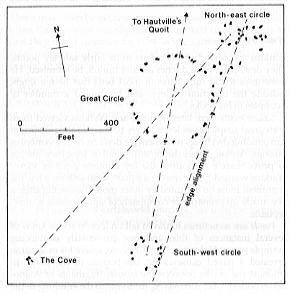
Article: BBC Jan 2010.
Archaeologists have discovered the collection
of prehistoric standing stones at Stanton Drew is older than
originally thought.
'During
geophysical surveys last summer, they found the outline of a
burial mound dated from nearly 1000 years before the stone
circles. The surveys were carried out by Bath and Camerton
Archaeological Society and the council's Archaeological
Officer.Their work has brought new light on the origins of the
Cove - the three large stones in the beer garden of the Druid's
Arms.
Stone
circles such as those at Stanton Drew are known to date broadly
to the late Neolithic and early Bronze Age, about 3000 to 2000
BC. The dig last summer found a burial mound from 1000 years
before the stone circle. The upright stones might be better
explained as the portals or facade of a chambered tomb'.
(Link to Full Article)
Stanton Drew: Gallery of Images:
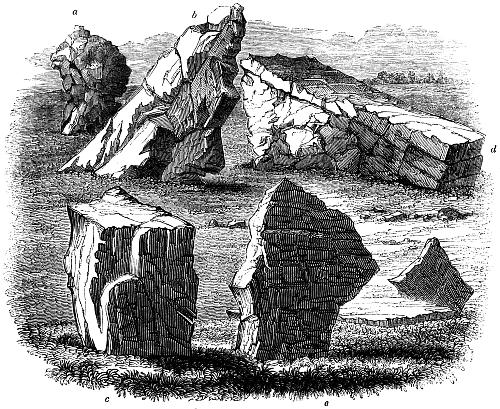
Engraving from ' �Old England- A
Pictorial Museum� By Charles Knight. (1845)
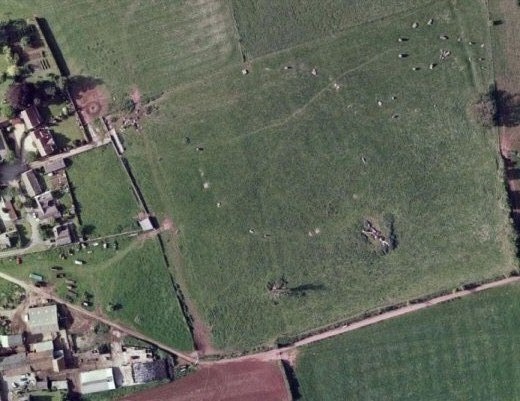
Overhead of Stanton Drew.
(Other Stone
Circles) (Other
Henges)
(Other
Prehistoric English Sites) |